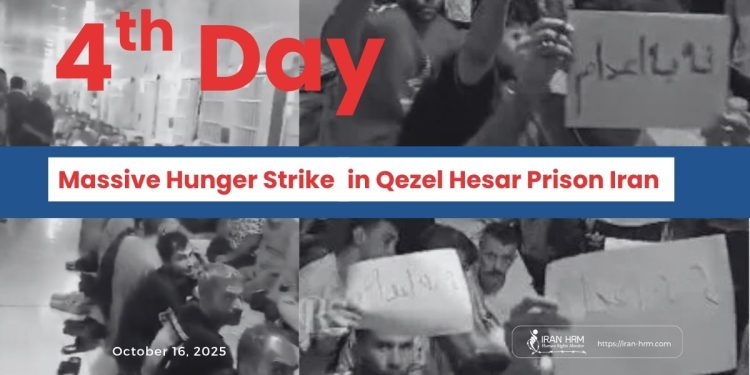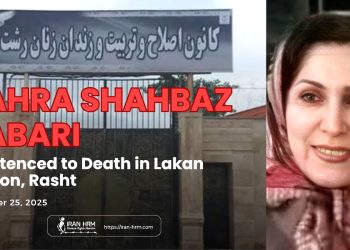Approximately 1,500 prisoners sentenced to death in Qezel Hesar Prison near Karaj have entered the fourth day of a collective hunger strike. The protest began on October 12, 2025, in response to a new wave of executions and the transfer of inmates to solitary confinement. Despite pressure, threats, and deteriorating health conditions, the prisoners continue their strike, demanding an immediate halt to all executions and the abolition of the death penalty.
1. Origins and Scale of the Strike
According to verified sources, the hunger strike began after 16 death row prisoners were transferred to solitary confinement for imminent execution. Soon after, chants of ‘No to execution’ echoed through multiple wards, and prisoners collectively refused food. At least eight prisoners were executed during the first two days of the protest, prompting widespread anger and solidarity among other wards. The strike has now expanded to Wards 2, 3, and 4 of Qezel Hesar, involving even elderly and ill prisoners.
2. Prison Conditions and Threats by Officials
The atmosphere in Qezel Hesar Prison is reported to be highly tense and militarized. Authorities have shut down common areas, cut off hot water, and restricted communications to suppress the strike. Several prisoners have lost consciousness due to extreme weakness but continue their protest. Sources report that the prison warden, Allah-Karam Azizi, visited Ward 2, offering to transfer some inmates without finalized sentences to other facilities. When prisoners refused, he allegedly threatened to accelerate executions if the strike continued.
3. Growing Solidarity and Family Support
Families of prisoners have expressed solidarity through small gatherings and social media messages, calling for an immediate end to executions. Slogans such as ‘No to execution’ and ‘Life is our right’ have gained traction both inside and outside Iran. State-controlled media attempted to discredit the protest by labeling participants as members of criminal gangs, but families insist the strike is a peaceful demand for the right to life.
4. Surge in Executions
Reports indicate that between October 12 and 14, at least 38 prisoners were executed across Iran — roughly one execution every two hours. These executions took place in Qezel Hesar, Arak, Shiraz, Ilam, Birjand, and Esfahan. Among the executed were Masoud Nematinejad, Alireza Razaghi (Arak), Milad Jahani (Shiraz), and Ahmad Beg Naseri (Ilam). Experts describe this surge as one of the deadliest in recent years.
5. International Reaction and Amnesty International Statement
Amnesty International issued a strong statement on October 16, 2025, ahead of the presentation of the UN Secretary-General’s report on Iran. Hussein Baoumi, Amnesty’s Deputy Regional Director for the Middle East and North Africa, stated:
“UN Member states must confront the Iranian authorities’ shocking execution spree with the urgency it demands. More than 1,000 people have already been executed in Iran since the beginning of 2025 – an average of four a day. Since the Woman Life Freedom uprising of 2022, the Iranian authorities have increasingly weaponized the death penalty to instill fear among the population, crush dissent and punish marginalized communities. This year, executions have reached a scale not seen in Iran since 1989.”
Amnesty further condemned the ongoing use of the death penalty for drug-related offences in blatant breach of international law, citing unfair trials and torture-induced confessions. The organization urged all UN member states to demand an immediate halt to executions, revoke anti-narcotic laws enabling capital punishment, and establish an official moratorium with a view to fully abolishing the death penalty. The full statement is available on Amnesty International’s website.
6. Media Coverage
Agence France-Presse (AFP) reported that prisoners in one of Iran’s largest prisons had launched a sit-in and hunger strike to protest the growing number of executions. AFP identified Qezel Hesar Prison as the site of the protest following the transfer of 16 inmates to solitary confinement. Asharq Al-Awsat similarly reported that prisoners chanted ‘No to executions’ in prison corridors, while families gathered outside demanding a halt to executions.
7. Legal Analysis
The mass executions and treatment of hunger-striking prisoners violate Iran’s obligations under the International Covenant on Civil and Political Rights (ICCPR):
– Article 6: The right to life prohibits arbitrary deprivation of life.
– Article 7: Prohibits torture and cruel or degrading treatment, including threats and deprivation of medical care.
– Article 10: Mandates humane treatment of all detainees. The surge in executions, often following unfair trials, reflects systemic disregard for due process and human dignity.
8. Human and Social Dimensions
The hunger strike represents a collective act of non-violent resistance against institutionalized death. Prisoners risk their lives to affirm their humanity and the right to life. Families outside the prison have become the voice of those inside, lighting candles and chanting slogans. This alignment between prisoners and civil society underscores a broader movement across Iran demanding justice and the end of capital punishment.
9. Conclusion and Calls to Action
The hunger strike at Qezel Hesar, now in its fourth day, underscores the urgent need for international intervention. Global institutions must act to prevent further loss of life and hold Iranian authorities accountable. Key recommendations include:
1. Immediate moratorium on all executions.
2. Independent access for UN Special Rapporteurs and humanitarian observers.
3. Provision of medical care and protection for hunger-striking prisoners.
4. Legal reforms toward complete abolition of the death penalty.
The message from Qezel Hesar resonates beyond prison walls: ‘No to execution — Yes to life.’







